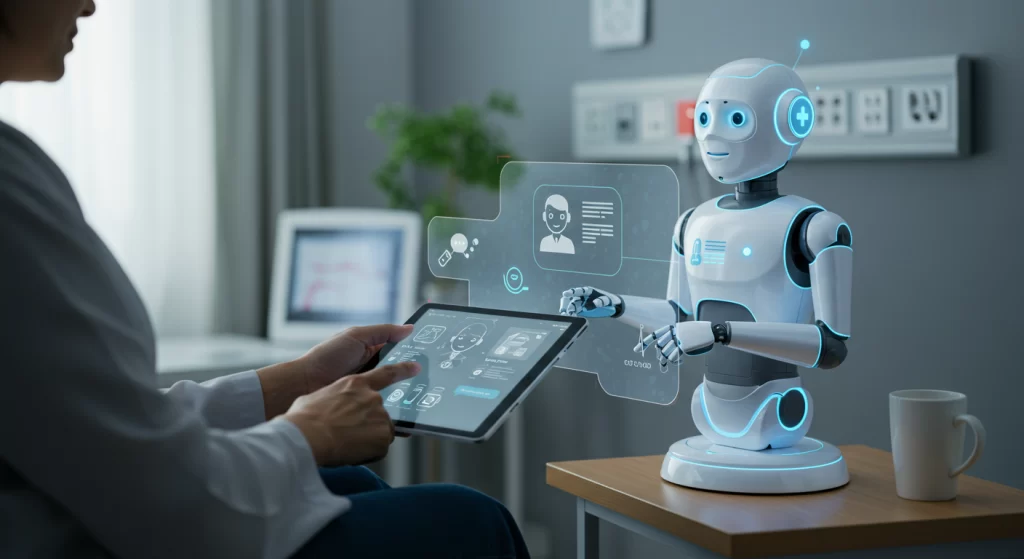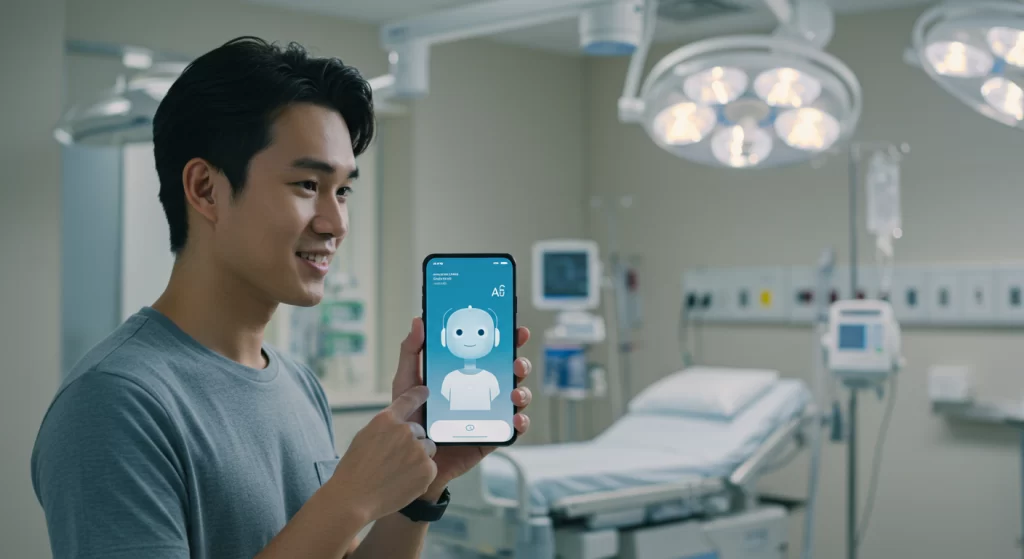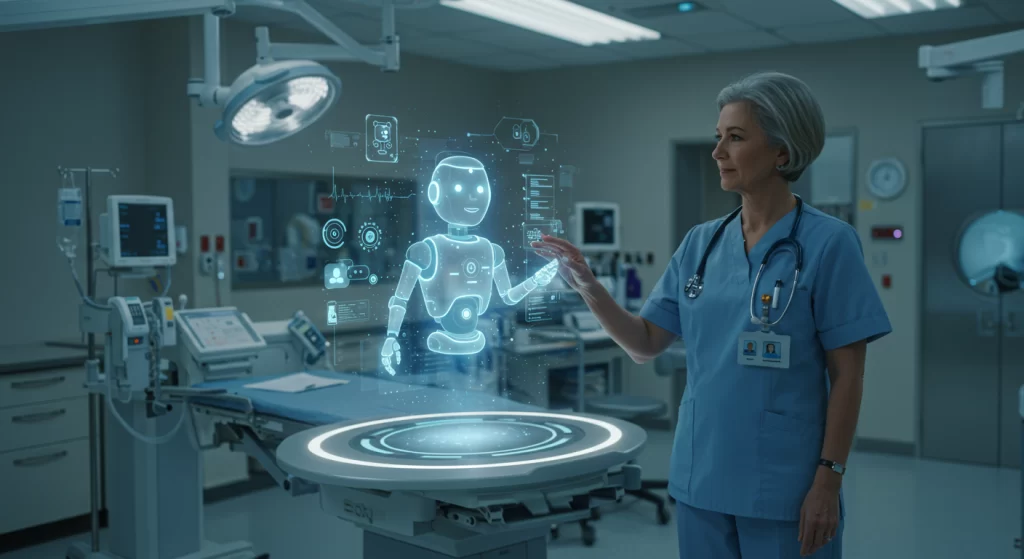The healthcare landscape is under significant strain, grappling with rising patient expectations, mounting administrative tasks, and the need for greater efficiency. Traditional communication channels often fall short, causing delays and potential care gaps. In response, medical organizations are increasingly adopting digital tools, with the AI voice chatbot emerging as a particularly promising solution.
Powered by Artificial Intelligence, these sophisticated systems enable natural, spoken conversations, offering a powerful way to enhance patient interactions, automate routine processes, and boost operational efficiency. As the technology rapidly advances, AI voice chatbots are transitioning from niche tools to essential components of modern healthcare.

This article explores the capabilities of the AI voice chatbot in healthcare. We will cover its definition, core techs, diverse applications, key considerations like integration and security, its impact on patients, and what defines the best AI chatbot with voice for medical providers.
Ready to explore how AI voice interactions can enhance your healthcare services? SPsoft has deep expertise in developing and integrating cutting-edge AI solutions!
Understanding the AI Voice Chatbot in a Healthcare Context
An AI voice chatbot in healthcare is an AI-driven application designed for spoken interactions with patients, caregivers, or staff. It uses AI, especially Natural Language Processing (NLP) and speech recognition, to understand verbal input and provide relevant spoken responses within a medical context. Its main goals are task automation, information provision, patient engagement, and improving efficiency in healthcare settings. Adoption is often driven by pressures like administrative overload and the need for immediate patient support.
The core process involves several steps: Automatic Speech Recognition (ASR) captures speech, Natural Language Understanding (NLU) interprets meaning, the system accesses relevant data (internal or via EHR integration), Natural Language Generation (NLG) formulates a response, and Text-to-Speech (TTS) delivers it verbally. Advanced AI voice chatbots can handle conversational shifts without losing context.
It is vital to differentiate an AI chatbot with voice from text-only chatbots. The key difference is the interaction mode: voice versus text. Voice requires ASR and TTS, adding complexity but enabling hands-free use, which boosts accessibility. Speaking is often faster than typing, potentially speeding up interactions, though development can be more resource-intensive.
A voice based AI chatbot also differs significantly from traditional Interactive Voice Response (IVR) systems. IVRs use rigid menus and keywords, whereas AI voice chatbots understand natural language and user intent. This leads to a more intuitive and less frustrating experience. While some systems blend AI with IVR, the core value of the AI voice chatbot lies in its ability to mimic natural conversation, reducing friction and enhancing usability, especially in hands-free or accessibility scenarios.
Table 1. AI Voice Chatbot vs Text Chatbot vs Traditional IVR: Key Features and Capabilities Comparison
| Feature | AI Voice Chatbot | Text Chatbot | Traditional IVR |
|---|---|---|---|
| Primary Interaction | Voice (Spoken Language) | Text (Typed Language) | Voice (Keywords/DTMF Tones) |
| Input Method | Microphone (Speech) | Keyboard/Screen (Text) | Microphone/Keypad (Phrases/Tones) |
| Output Method | Speaker (Synthesized Speech) | Screen (Text) | Speaker (Pre-recorded/Simple TTS) |
| Understanding Capability | Deep Intent & Context (NLP/NLU) | Intent & Context (NLP/NLU) | Keyword Matching/Menu Logic |
| Conversation Flow | Natural, Fluid, Handles Interruptions | Conversational, Can Handle Context | Rigid, Menu-Driven, Limited Paths |
| Key Technologies | ASR, NLP (NLU/NLG), TTS, ML | NLP (NLU/NLG), ML | DTMF Recognition, Basic ASR/TTS |
| Typical Use Case Complexity | High (Complex Queries, Multi-turn Dialogues) | Medium-High (Information, Transactions, Support) | Low (Routing, Simple Information) |
| User Experience | Natural, Accessible, Hands-Free, Potentially Empathetic | Convenient, Accessible via Text | Often Frustrating, Rigid, Impersonal |
How AI Voice Chatbots Speak: The Core Technology
The conversational ability of an AI voice chatbot stems from the synergy of several core AI technologies: Automatic Speech Recognition (ASR), Natural Language Processing (NLP) (including Natural Language Understanding – NLU and Natural Language Generation – NLG), Text-to-Speech (TTS) synthesis, and underlying Machine Learning (ML) models.
Automatic Speech Recognition (ASR)
ASR initiates the process by converting spoken language into text. It captures audio, filters noise, analyzes acoustic signals, identifies phonemes, and uses language models to transcribe sounds into words. High accuracy is crucial, especially in healthcare, requiring the system to handle diverse accents, speech rates, and noisy environments.
Natural Language Processing (NLP)
Once speech is text, NLP interprets and generates human language meaningfully. It acts as the system’s “brain” and involves two key parts:
- Natural Language Understanding (NLU). NLU deciphers the meaning and intent behind the user’s words. It determines the user’s goal (asking, requesting, etc.). In healthcare, NLU must grasp medical terms and patient descriptions, which can be vague.
- Natural Language Generation (NLG). NLG constructs grammatically correct and contextually appropriate text responses. Based on NLU analysis and retrieved information, NLG crafts the message to address the user’s need.
Text-to-Speech (TTS)
TTS, or speech synthesis, converts the NLG-generated text back into audible speech. Modern TTS aims for highly natural, human-like voices, avoiding robotic tones. Advanced engines replicate speech nuances like intonation, rhythm, and even empathy, vital for healthcare interactions. Voice options (gender, accent, language) are often available.
Machine Learning (ML)
ML underpins these components. Algorithms trained on vast speech and text datasets enable ASR, NLP, and TTS functionality. ML models learn language patterns, semantics, and acoustics. Continuous learning improves the AI voice chatbot’s accuracy and responsiveness over time.

The system’s overall effectiveness depends on the seamless integration and performance of these layers. Weaknesses in ASR, NLU, or TTS can degrade the user experience. The quality of these technologies, especially NLP’s understanding and TTS’s naturalness and empathy, determines the chatbot’s perceived intelligence and helpfulness.
Technical Capabilities and Considerations for Healthcare
Deploying a voice based AI chatbot in healthcare demands careful consideration of critical technical aspects. Unlike less sensitive domains, healthcare applications require exceptional accuracy, security, integration, and user experience.

Accuracy: Understanding Medical Nuances
Accuracy is paramount in healthcare. Incorrect information or misunderstood symptoms can have severe consequences. Medical language complexity (jargon, acronyms) and vague patient descriptions pose challenges.
The best AI chatbot with voice solutions address this through:
- Specialized Training. Using large, curated medical datasets.
- Domain-Specific NLP. Employing techniques like medical Named Entity Recognition and semantic understanding.
- Contextual Awareness. Remembering conversational history.
- Sentiment Analysis. Gauging patient emotional state for added context.
While accuracy rates are promising in specific tasks (e.g., >80% in clinical text classification), perfection is elusive, especially for complex cases. Continuous monitoring and retraining are vital.
Integration: Connecting with EHRs and Standards
Seamless integration with healthcare IT, especially Electronic Health Records (EHRs) like Epic and Cerner, is crucial for accessing patient data and documenting interactions. This personalization and record-keeping enhance clinical workflow.
Interoperability relies on standards:
- HL7 FHIR. The modern standard using APIs (often RESTful) and formats like JSON/XML for exchanging health data. FHIR support enables communication with compliant EHRs.
- HL7 V2. Support may be needed for legacy systems.
Integration challenges include system compatibility, technical hurdles, implementation costs, and legacy infrastructure.
Deployment: Flexibility Across Channels
Healthcare organizations need deployment flexibility :
- Phone Systems/IVR. Integrating with call centers to automate calls (scheduling, FAQs, reminders), transforming traditional IVR into conversational experiences.
- Mobile Apps. Embedding voice capabilities via SDKs/APIs for hands-free interaction within health apps (e.g., symptom logging). Requires careful permission handling.
- Websites. Adding voice-enabled widgets for immediate assistance.
- Smart Speakers. Technically feasible for certain information/reminders, though privacy concerns exist in formal settings.
An omnichannel strategy, ensuring consistent experience across touchpoints, is increasingly important.
Security: Safeguarding Data and Ensuring HIPAA Compliance
Security and privacy are non-negotiable due to sensitive health data and high breach risks. Compliance with regulations like HIPAA (US) is mandatory. Standard consumer AI models (like basic ChatGPT) are not HIPAA compliant without specific safeguards and agreements.
Reputable healthcare AI voice chatbots implement robust security:
- Data Encryption. In transit and at rest.
- Access Controls. Authorization and authentication (e.g., role-based access, voice biometrics).
- Secure Infrastructure. Secure database practices and infrastructure.
- Compliance & Auditing. Adherence to HIPAA (including BAAs) and regular audits.
- Data Anonymization. Removing identifiable information where appropriate.
- Deployment Control. On-premise or hybrid options for greater data control.
Voice Quality: Naturalness and Empathy
The TTS voice quality significantly impacts user acceptance. The goal is natural, engaging, and empathetic speech, avoiding robotic tones. People often perceive modern AI voices as natural.

Achieving empathy involves modeling subtle speech nuances (tone, pitch, rhythm). Advanced systems may use sentiment analysis to adjust vocal tone dynamically. Leading research focuses on emotionally intelligent AI voices (e.g., Hume AI, Hippocratic AI/NVIDIA, Respeecher).
Low latency (minimal response delay) is crucial for a natural emotional connection. Even small improvements significantly enhance the perception of care.
Escalation: Seamless Handoff to Humans
No bot is perfect; smooth escalation to human agents is vital for satisfaction and safety. Users prioritize this capability.
Effective escalation involves:
- Trigger Identification. Bot recognizes when human help is needed (complexity, user distress, specific keywords, direct request).
- Seamless Transfer. Call/chat is transferred smoothly to the appropriate human agent.
- Context Preservation. Conversation history is passed to the agent, avoiding repetition.
These technical capabilities are interconnected. High standards across all dimensions are essential for successful and responsible AI voice chatbot implementation in healthcare.
The Patient Perspective: Experience, Benefits, and Challenges
The success of a healthcare AI voice chatbot ultimately depends on the patient experience. Understanding their perceptions, benefits, and frustrations is key to effective design and deployment.
Benefits for Patients
Well-implemented AI voice chatbots offer patients several advantages:
- Accessibility & Convenience. 24/7 availability removes time and location barriers. Hands-free operation aids multitasking and those with physical limitations. Improves access for visually impaired, low-literacy, or remote individuals.
- Efficiency & Speed. Immediate responses eliminate long wait times for common queries.1 Simple issues are resolved faster.
- Engagement & Empowerment. Easier access to information encourages active health management. Personalized reminders and support can improve understanding, adherence, and outcomes.
- Consistency. Standardized information delivery ensures consistent responses.
- Anonymity/Reduced Stigma. Some patients feel more comfortable discussing sensitive topics or mental health with a non-judgmental bot.
Challenges and Drawbacks for Patients
Patients also encounter difficulties:
- Lack of Human Empathy. The absence of genuine human warmth is a major drawback, especially for complex or emotional health issues. Many prefer human interaction for sensitive matters.
- Potential Frustration. Poorly designed bots that misunderstand, loop, give irrelevant answers, sound robotic, or hinder escalation cause frustration.
- Trust and Privacy Concerns. Hesitancy to share sensitive health data due to security fears, potential misuse, or lack of trust in technology. Data breach news exacerbates these concerns.
- Accuracy Worries. Concerns about the reliability of information and potential for incorrect medical advice or misinterpretations.
- Technical Issues. Downtime, bugs, or glitches lead to negative experiences.
- Algorithmic Aversion. Some users dislike automated systems and may disengage upon realizing they are interacting with a bot.
Patient Acceptance and Satisfaction
Research shows varied patient acceptance. While some studies report high satisfaction (e.g., 80% positive experience, 27% CSAT increase), others show mixed results (e.g., 41% positive, 25% neutral, 15% negative in one study). Acceptance is higher for simple tasks (scheduling, basic info) than complex diagnostics or emotional support.
Key factors influencing satisfaction include:

- Performance. Accuracy, ease of use, and successful issue resolution are crucial.
- Trustworthiness. A major factor influencing usage intention. Correct predictions enhance trust.
- Prior Exposure. More experience with a chatbot may lead to greater perceived benefit.
- Disclosure. Explicitly identifying the bot might not harm trust for task-focused applications like medication reconciliation.
- Design. Visual branding might help reduce privacy concerns.
Case studies demonstrate positive impacts, such as increased appointment adherence and improved self-care behaviors in cancer patients. The PD Coach app also shows enhanced support for Parkinson’s patients.
A significant tension exists between the convenience of AI voice chatbots and the patient’s need for human empathy and trust. Navigating this requires thoughtful design, robust technology, transparency, and clear escalation paths. Satisfaction depends heavily on the bot’s performance, design, and the specific use context.
Identifying the Best AI Chatbot with Voice for Your Medical Needs
Choosing the right AI voice chatbot is crucial. The “best” solution aligns with an organization’s specific clinical, administrative, and patient experience goals while meeting stringent healthcare requirements. Evaluation should focus on key features.
Key Features of a Top-Tier Healthcare AI Voice Chatbot
Prioritize these capabilities when evaluating options:
- High Accuracy & Reliability. Exceptional understanding of medical terms, patient intent, and providing correct information is vital for safety and trust.
- Robust Security & HIPAA Compliance. Mandatory features include end-to-end encryption, access controls, audit logs, HIPAA compliance (with BAAs), and secure infrastructure.
- Seamless Integration. Proven integration with major EHRs (Epic, Cerner), support for standards (HL7 FHIR via APIs), and potential links to CRM, billing, or telephony. Look for well-documented APIs.
- Natural & Empathetic Voice (TTS). A clear, natural-sounding voice with the ability to convey appropriate tones like empathy enhances patient experience. Low latency is key.
- Advanced Conversational AI (NLP/NLU). Capable of handling complex, multi-turn dialogues, understanding context, and managing interruptions gracefully.
- Effective Escalation. Reliable mechanisms for identifying the need for human help and executing smooth, context-preserving handoffs.
- Customization & Control. Ability to tailor the bot’s persona, voice, responses, flows, and logic to organizational needs.
- Scalability. Ability to handle fluctuating interaction volumes efficiently without performance degradation.
- Analytics & Reporting. Tools to monitor performance, track metrics (resolution rates, CSAT), identify improvements, and gain insights.
- Deployment Flexibility. Cloud, on-premise, or hybrid options to meet infrastructure, security, and data governance needs.
Insights from Examples
Real-world examples show tangible benefits and ROI: increased patient adherence, significant cost savings (often 30%+), and improved patient satisfaction. Case studies like ChemoFreeBot demonstrate direct improvements in patient self-care.
Making the Choice
Choosing the best AI chatbot with voice requires thorough evaluation against unique requirements. Compare vendors (e.g., IBM Watson, Amazon Q, Cognigy, Rasa, Suki AI, Abridge, Hume AI, Hippocratic AI) focusing on healthcare-specific expertise, understanding patient communication nuances, clinical workflows, and compliance. The optimal choice balances advanced tech with deep healthcare context.
Final Thoughts
The AI voice chatbot is poised to significantly reshape healthcare communication and efficiency. By automating tasks, providing instant information access, and engaging patients naturally, these systems enhance experience, reduce staff burden, improve workflows, and increase care accessibility.
Realizing this potential requires addressing challenges like ensuring accuracy, seamless integration, robust security, HIPAA compliance, and fostering patient trust. This demands careful planning, the right technology partners, user-centric design, and ethical implementation. Balancing efficiency with the human need for empathy remains crucial.
The future of AI voice chatbots in healthcare involves continued growth and sophistication. Advancements in AI, NLP, and emotionally intelligent TTS promise even more natural and empathetic interactions. Expect deeper clinical integration and wider adoption, making these tools core components of patient engagement strategies. Healthcare interaction is becoming increasingly conversational, with the AI voice chatbot leading the way.
Ready to embrace the future of patient communication and operational efficiency? Partner with SPsoft to develop and integrate a custom AI voice chatbot!
FAQ
What is an AI voice chatbot in healthcare?
An AI voice chatbot in healthcare is a specialized AI program using NLP and speech recognition to understand spoken language and converse with patients or staff. It automates tasks like scheduling, answers health questions, provides reminders, and offers support via voice.
Can it really understand medical questions accurately?
Accuracy is improving. The best AI chatbot with voice solutions are trained on medical data and use advanced NLP. They handle many common queries well, but complex situations can be challenging. Accuracy depends on training quality and the AI model. They are not substitutes for professional diagnosis.
What tasks can a healthcare voice chatbot handle?
A voice based AI chatbot handles tasks like appointment scheduling/reminders, answering FAQs, medication reminders/refills, preliminary symptom checks, post-discharge follow-up, patient intake, wellness tips, and administrative support.
Can the voice chatbot integrate with EHR systems like Epic or Cerner?
Yes, leading platforms integrate with major EHRs like Epic and Cerner, allowing seamless data flow for retrieving patient info or updating records.
Does it support FHIR or HL7 standards?
Integration often uses standards like HL7 FHIR via APIs for easier data exchange with EHRs and other systems. Support for older HL7 versions may also exist.
Can it be deployed on phone systems, mobile apps, or websites?
Yes, an AI chatbot with voice is versatile. It can integrate with phone systems (conversational IVR), be embedded in mobile apps (SDKs/APIs), placed on websites, or accessed via smart speakers.
How is sensitive patient information handled securely?
Security is crucial. Reputable healthcare AI voice chatbots use data encryption, secure authentication, access controls, HIPAA compliance (US), secure storage, and may offer on-premise deployment.
Does it sound natural and empathetic?
Modern TTS aims for natural, human-like voices. Advanced AI voice chatbots, especially those for healthcare, can incorporate emotional nuances and empathetic tones for a better patient experience. Quality varies.
Will patients get frustrated talking to a bot instead of a human?
Frustration is possible if the bot misunderstands, fails to resolve issues, or lacks empathy. Well-designed bots that are accurate, efficient, sound natural, and offer easy escalation minimize frustration. Many appreciate the convenience for routine tasks.
Can it escalate to a live agent if needed?
Yes, a key feature is intelligent escalation to a human agent when needed (complex query, patient request). The handover should be seamless and include conversation context.



